Analysis of Case Study: Children with Disabilities and Society
VerifiedAdded on 2023/01/11
|10
|2728
|52
Case Study
AI Summary
This case study examines the multifaceted challenges faced by children with disabilities, focusing on societal perceptions, the impact of conditions like chronic fatigue syndrome (CFS), and relevant legislation. The case study highlights the difficulties children with disabilities face, including social isolation, discrimination, and the fluctuating nature of their conditions, which often leads to misunderstandings from peers and the broader community. It explores the role of parents and families in supporting these children, emphasizing the emotional and practical burdens they bear. Furthermore, the study delves into the historical context of disability, examining the role of government policies like the Equality Act 2010 and the Children Act 1989 in protecting the rights and welfare of disabled children. It also discusses the role of organizations and councils in advocating for policy changes and ensuring the implementation of inclusive practices across various sectors, advocating for better understanding, support, and equity for children with disabilities and their families. The study emphasizes the importance of recognizing disability as a normal aspect of human diversity and promoting an environment that removes barriers to their full participation in society.
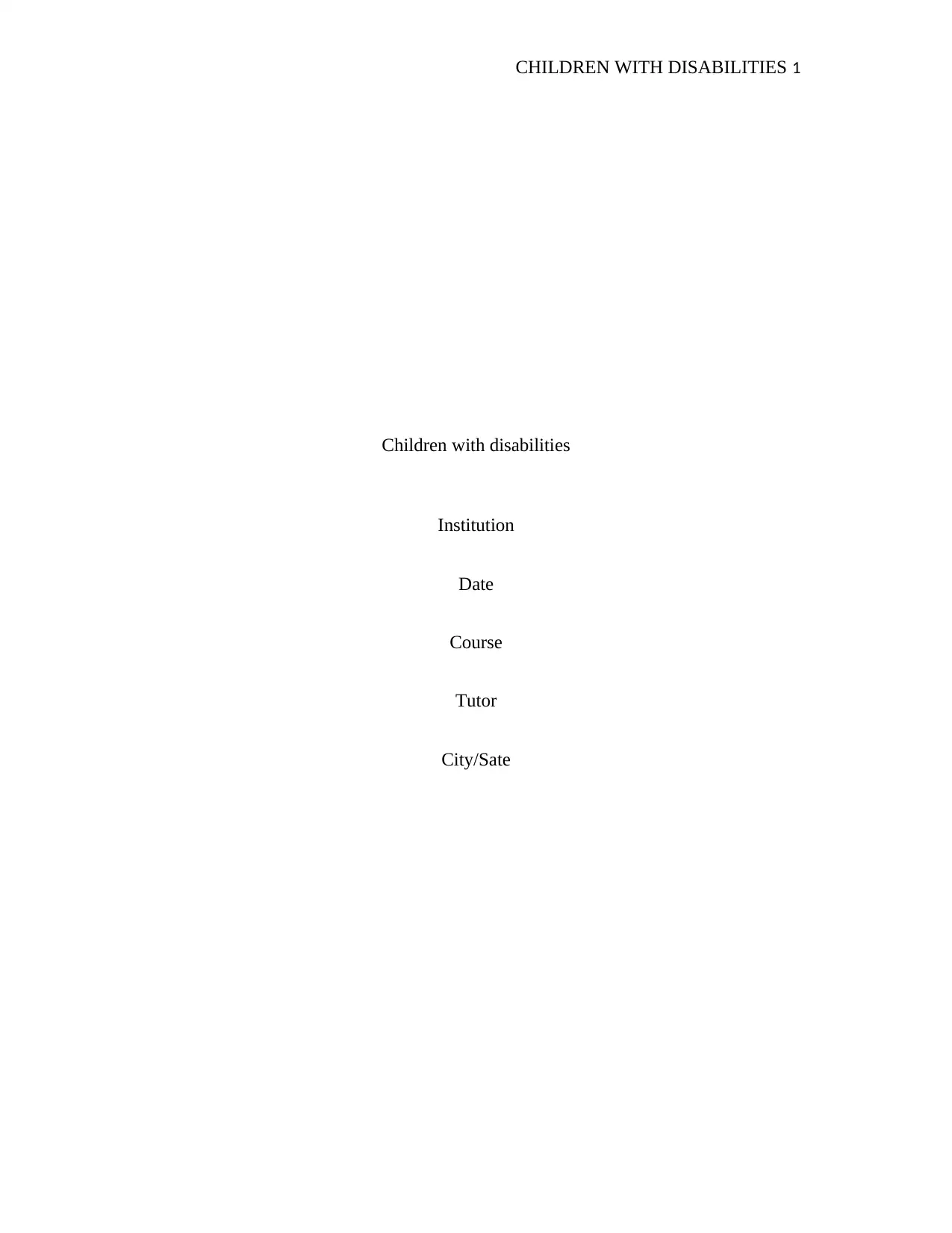
CHILDREN WITH DISABILITIES 1
Children with disabilities
Institution
Date
Course
Tutor
City/Sate
Children with disabilities
Institution
Date
Course
Tutor
City/Sate
Paraphrase This Document
Need a fresh take? Get an instant paraphrase of this document with our AI Paraphraser
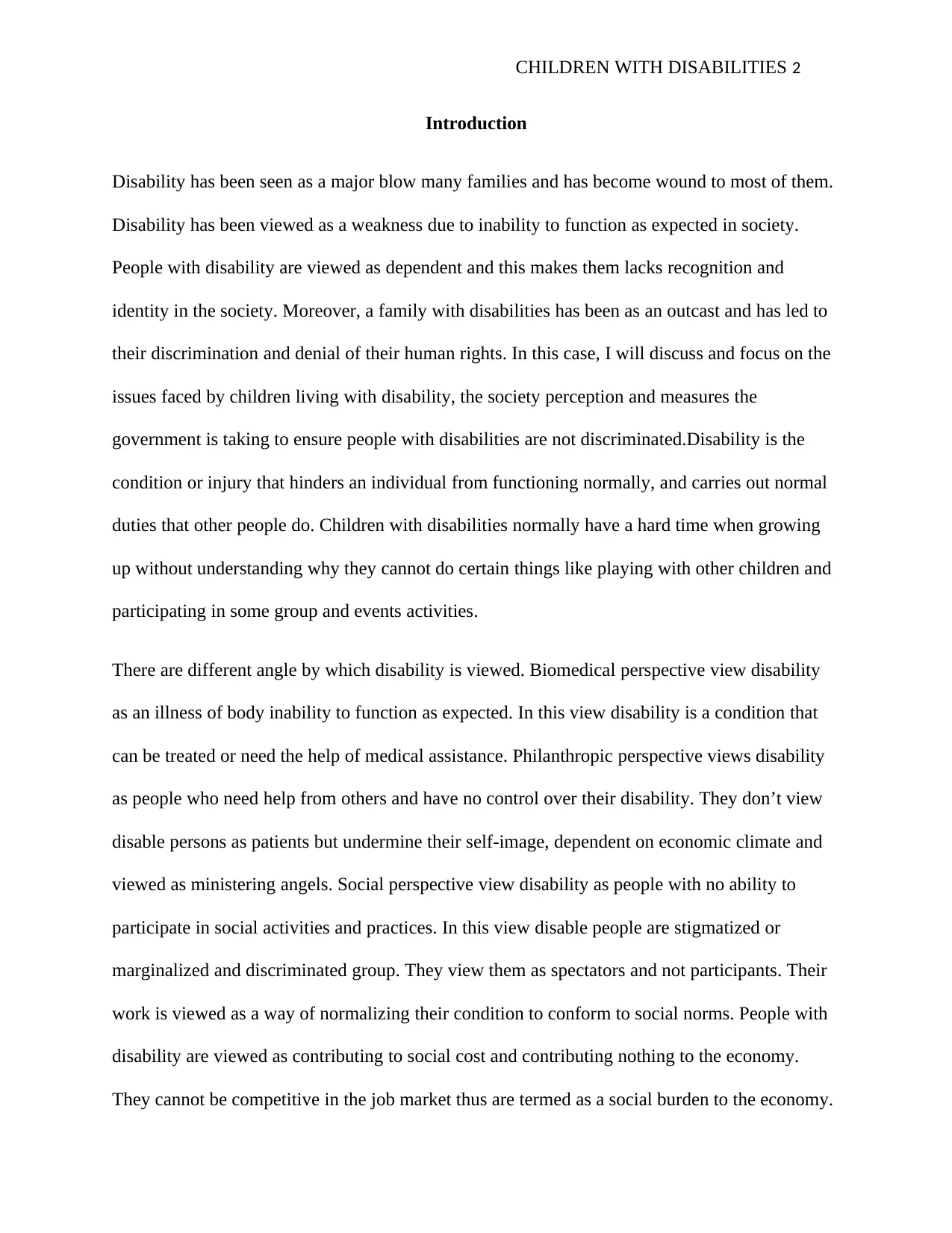
CHILDREN WITH DISABILITIES 2
Introduction
Disability has been seen as a major blow many families and has become wound to most of them.
Disability has been viewed as a weakness due to inability to function as expected in society.
People with disability are viewed as dependent and this makes them lacks recognition and
identity in the society. Moreover, a family with disabilities has been as an outcast and has led to
their discrimination and denial of their human rights. In this case, I will discuss and focus on the
issues faced by children living with disability, the society perception and measures the
government is taking to ensure people with disabilities are not discriminated.Disability is the
condition or injury that hinders an individual from functioning normally, and carries out normal
duties that other people do. Children with disabilities normally have a hard time when growing
up without understanding why they cannot do certain things like playing with other children and
participating in some group and events activities.
There are different angle by which disability is viewed. Biomedical perspective view disability
as an illness of body inability to function as expected. In this view disability is a condition that
can be treated or need the help of medical assistance. Philanthropic perspective views disability
as people who need help from others and have no control over their disability. They don’t view
disable persons as patients but undermine their self-image, dependent on economic climate and
viewed as ministering angels. Social perspective view disability as people with no ability to
participate in social activities and practices. In this view disable people are stigmatized or
marginalized and discriminated group. They view them as spectators and not participants. Their
work is viewed as a way of normalizing their condition to conform to social norms. People with
disability are viewed as contributing to social cost and contributing nothing to the economy.
They cannot be competitive in the job market thus are termed as a social burden to the economy.
Introduction
Disability has been seen as a major blow many families and has become wound to most of them.
Disability has been viewed as a weakness due to inability to function as expected in society.
People with disability are viewed as dependent and this makes them lacks recognition and
identity in the society. Moreover, a family with disabilities has been as an outcast and has led to
their discrimination and denial of their human rights. In this case, I will discuss and focus on the
issues faced by children living with disability, the society perception and measures the
government is taking to ensure people with disabilities are not discriminated.Disability is the
condition or injury that hinders an individual from functioning normally, and carries out normal
duties that other people do. Children with disabilities normally have a hard time when growing
up without understanding why they cannot do certain things like playing with other children and
participating in some group and events activities.
There are different angle by which disability is viewed. Biomedical perspective view disability
as an illness of body inability to function as expected. In this view disability is a condition that
can be treated or need the help of medical assistance. Philanthropic perspective views disability
as people who need help from others and have no control over their disability. They don’t view
disable persons as patients but undermine their self-image, dependent on economic climate and
viewed as ministering angels. Social perspective view disability as people with no ability to
participate in social activities and practices. In this view disable people are stigmatized or
marginalized and discriminated group. They view them as spectators and not participants. Their
work is viewed as a way of normalizing their condition to conform to social norms. People with
disability are viewed as contributing to social cost and contributing nothing to the economy.
They cannot be competitive in the job market thus are termed as a social burden to the economy.

CHILDREN WITH DISABILITIES 3
On social politic, disability problems find their root on politic and can be solved on the political
point of view. Disability is the connection between individual, physical and social environment
and cannot be understood in isolation from social environment and the world that create
limitations experienced by the disables. This perspective focuses on understanding the individual
abilities and views but not the views of the experts. It also looks into promoting and improving
the conducive environment for the disabled. This perspective makes people with disability
understand that disability is normal. It focuses on ways of improving their livelihood and
removing barriers in which the world think of the disabled people. It also promotes the society in
understanding the values of individual rights and from creating barriers that promote disabilities
(Goodley, Hughes and Davis, 2012).
In the study case we find that, People with disabilities develop lots of anger and frustration
throughout their day to day life. Watching other people do things that they cannot do due to their
condition makes them feel so frustrated and left out. This build up anger makes them direct it to
other people. People don’t understand why to disable people are sometimes so frustrated. They
feel robbed part of their life since they cannot enjoy right and access of services due to their
condition. It makes them regret and bother their parents or their caregiver and may sometime
want to lead them out of the state of disability. Pent up anger can be damaging to children with
disability. According to Holtz, T.(2006), anger can lead to anxiety disorder, high blood pressure,
muscle spasm, depression and eating disorders to people living with disabilities. Research shows
that people living with disabilities have a higher percentage of stress than normal people
(Tessman 2016, p. 67).
Parents with disabled children are always depressed and this reflects much on their disabled
children. The research indicates that more than 41% of the mother with disabled children suffers
On social politic, disability problems find their root on politic and can be solved on the political
point of view. Disability is the connection between individual, physical and social environment
and cannot be understood in isolation from social environment and the world that create
limitations experienced by the disables. This perspective focuses on understanding the individual
abilities and views but not the views of the experts. It also looks into promoting and improving
the conducive environment for the disabled. This perspective makes people with disability
understand that disability is normal. It focuses on ways of improving their livelihood and
removing barriers in which the world think of the disabled people. It also promotes the society in
understanding the values of individual rights and from creating barriers that promote disabilities
(Goodley, Hughes and Davis, 2012).
In the study case we find that, People with disabilities develop lots of anger and frustration
throughout their day to day life. Watching other people do things that they cannot do due to their
condition makes them feel so frustrated and left out. This build up anger makes them direct it to
other people. People don’t understand why to disable people are sometimes so frustrated. They
feel robbed part of their life since they cannot enjoy right and access of services due to their
condition. It makes them regret and bother their parents or their caregiver and may sometime
want to lead them out of the state of disability. Pent up anger can be damaging to children with
disability. According to Holtz, T.(2006), anger can lead to anxiety disorder, high blood pressure,
muscle spasm, depression and eating disorders to people living with disabilities. Research shows
that people living with disabilities have a higher percentage of stress than normal people
(Tessman 2016, p. 67).
Parents with disabled children are always depressed and this reflects much on their disabled
children. The research indicates that more than 41% of the mother with disabled children suffers
⊘ This is a preview!⊘
Do you want full access?
Subscribe today to unlock all pages.

Trusted by 1+ million students worldwide

CHILDREN WITH DISABILITIES 4
from disease related to stress (Jaeyoung 2018 p.440). Children psychological problem related to
their intellect and function limitation results from their relationship with their parents and family
members (Masulani-Mwale, et al. 2019, p.9). Parenting a disabled child becomes a great
challenge especially to mothers who feel their joy robbed. The desire of every parent is to see
their children grow up normal with all the abilities to participate in all activities like other
children. This has forced many parents to sacrifice their position in the workplace to care for
their children since they are the only one who understands them (Theresa & C Clark 2017,
p857). The parents are the only hope disabled children have since it is hard for them to make
permanent friends and they are the only one who understands their weakness and the main shield
of protection to their children. Having to deal with these issues on a daily basis makes it difficult
for parents and stressful. The most difficult time for parents with disabled children is when they
are in their teenage hood. It is that moment when the relationship turns out to be sour. It is the
time parents have to act the bad guy if they want better for their children. Sticking to your
parenting role becomes tough since they have to protect their children at all cost from challenges
that face teenagers. Social factors is another challenge parents face, it becomes very difficult for
parents to answer thousands of question that come from other people explaining the condition of
their children. Also making other children understand why your child is different becomes
another huddle. Of course, their parents may tend to give them all sorts of answers to satisfy their
curiosity but as a parent, you are the only one who knows what your child is suffering from.
Perception to people with disability is different than you can think. From the case study, it is
though that people with disability have low IQ, hard to understand and dependent (Owuso 2018,
p.12). it is perceived that, disable people do not have rights to enjoy life like anyone else. In the
from disease related to stress (Jaeyoung 2018 p.440). Children psychological problem related to
their intellect and function limitation results from their relationship with their parents and family
members (Masulani-Mwale, et al. 2019, p.9). Parenting a disabled child becomes a great
challenge especially to mothers who feel their joy robbed. The desire of every parent is to see
their children grow up normal with all the abilities to participate in all activities like other
children. This has forced many parents to sacrifice their position in the workplace to care for
their children since they are the only one who understands them (Theresa & C Clark 2017,
p857). The parents are the only hope disabled children have since it is hard for them to make
permanent friends and they are the only one who understands their weakness and the main shield
of protection to their children. Having to deal with these issues on a daily basis makes it difficult
for parents and stressful. The most difficult time for parents with disabled children is when they
are in their teenage hood. It is that moment when the relationship turns out to be sour. It is the
time parents have to act the bad guy if they want better for their children. Sticking to your
parenting role becomes tough since they have to protect their children at all cost from challenges
that face teenagers. Social factors is another challenge parents face, it becomes very difficult for
parents to answer thousands of question that come from other people explaining the condition of
their children. Also making other children understand why your child is different becomes
another huddle. Of course, their parents may tend to give them all sorts of answers to satisfy their
curiosity but as a parent, you are the only one who knows what your child is suffering from.
Perception to people with disability is different than you can think. From the case study, it is
though that people with disability have low IQ, hard to understand and dependent (Owuso 2018,
p.12). it is perceived that, disable people do not have rights to enjoy life like anyone else. In the
Paraphrase This Document
Need a fresh take? Get an instant paraphrase of this document with our AI Paraphraser
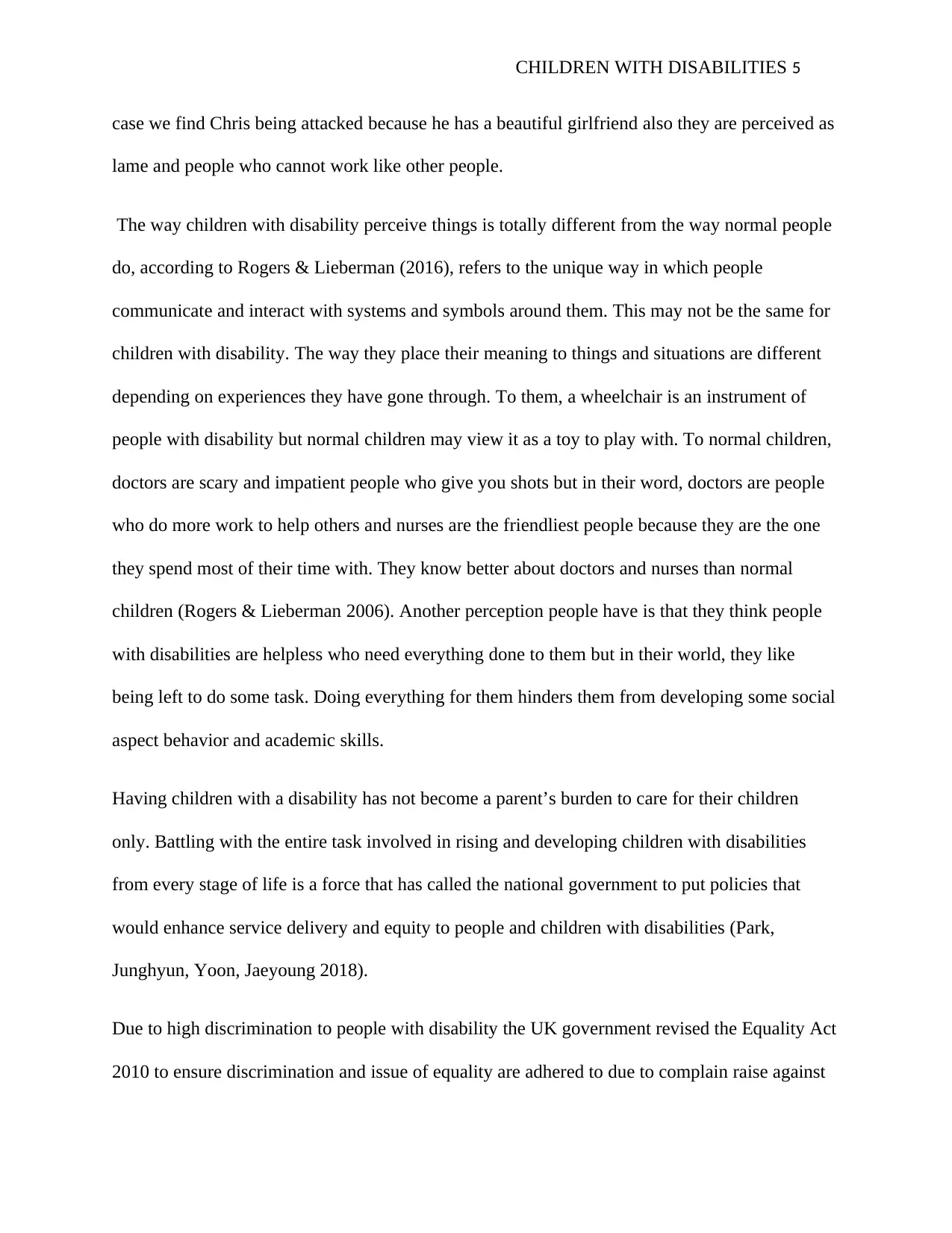
CHILDREN WITH DISABILITIES 5
case we find Chris being attacked because he has a beautiful girlfriend also they are perceived as
lame and people who cannot work like other people.
The way children with disability perceive things is totally different from the way normal people
do, according to Rogers & Lieberman (2016), refers to the unique way in which people
communicate and interact with systems and symbols around them. This may not be the same for
children with disability. The way they place their meaning to things and situations are different
depending on experiences they have gone through. To them, a wheelchair is an instrument of
people with disability but normal children may view it as a toy to play with. To normal children,
doctors are scary and impatient people who give you shots but in their word, doctors are people
who do more work to help others and nurses are the friendliest people because they are the one
they spend most of their time with. They know better about doctors and nurses than normal
children (Rogers & Lieberman 2006). Another perception people have is that they think people
with disabilities are helpless who need everything done to them but in their world, they like
being left to do some task. Doing everything for them hinders them from developing some social
aspect behavior and academic skills.
Having children with a disability has not become a parent’s burden to care for their children
only. Battling with the entire task involved in rising and developing children with disabilities
from every stage of life is a force that has called the national government to put policies that
would enhance service delivery and equity to people and children with disabilities (Park,
Junghyun, Yoon, Jaeyoung 2018).
Due to high discrimination to people with disability the UK government revised the Equality Act
2010 to ensure discrimination and issue of equality are adhered to due to complain raise against
case we find Chris being attacked because he has a beautiful girlfriend also they are perceived as
lame and people who cannot work like other people.
The way children with disability perceive things is totally different from the way normal people
do, according to Rogers & Lieberman (2016), refers to the unique way in which people
communicate and interact with systems and symbols around them. This may not be the same for
children with disability. The way they place their meaning to things and situations are different
depending on experiences they have gone through. To them, a wheelchair is an instrument of
people with disability but normal children may view it as a toy to play with. To normal children,
doctors are scary and impatient people who give you shots but in their word, doctors are people
who do more work to help others and nurses are the friendliest people because they are the one
they spend most of their time with. They know better about doctors and nurses than normal
children (Rogers & Lieberman 2006). Another perception people have is that they think people
with disabilities are helpless who need everything done to them but in their world, they like
being left to do some task. Doing everything for them hinders them from developing some social
aspect behavior and academic skills.
Having children with a disability has not become a parent’s burden to care for their children
only. Battling with the entire task involved in rising and developing children with disabilities
from every stage of life is a force that has called the national government to put policies that
would enhance service delivery and equity to people and children with disabilities (Park,
Junghyun, Yoon, Jaeyoung 2018).
Due to high discrimination to people with disability the UK government revised the Equality Act
2010 to ensure discrimination and issue of equality are adhered to due to complain raise against
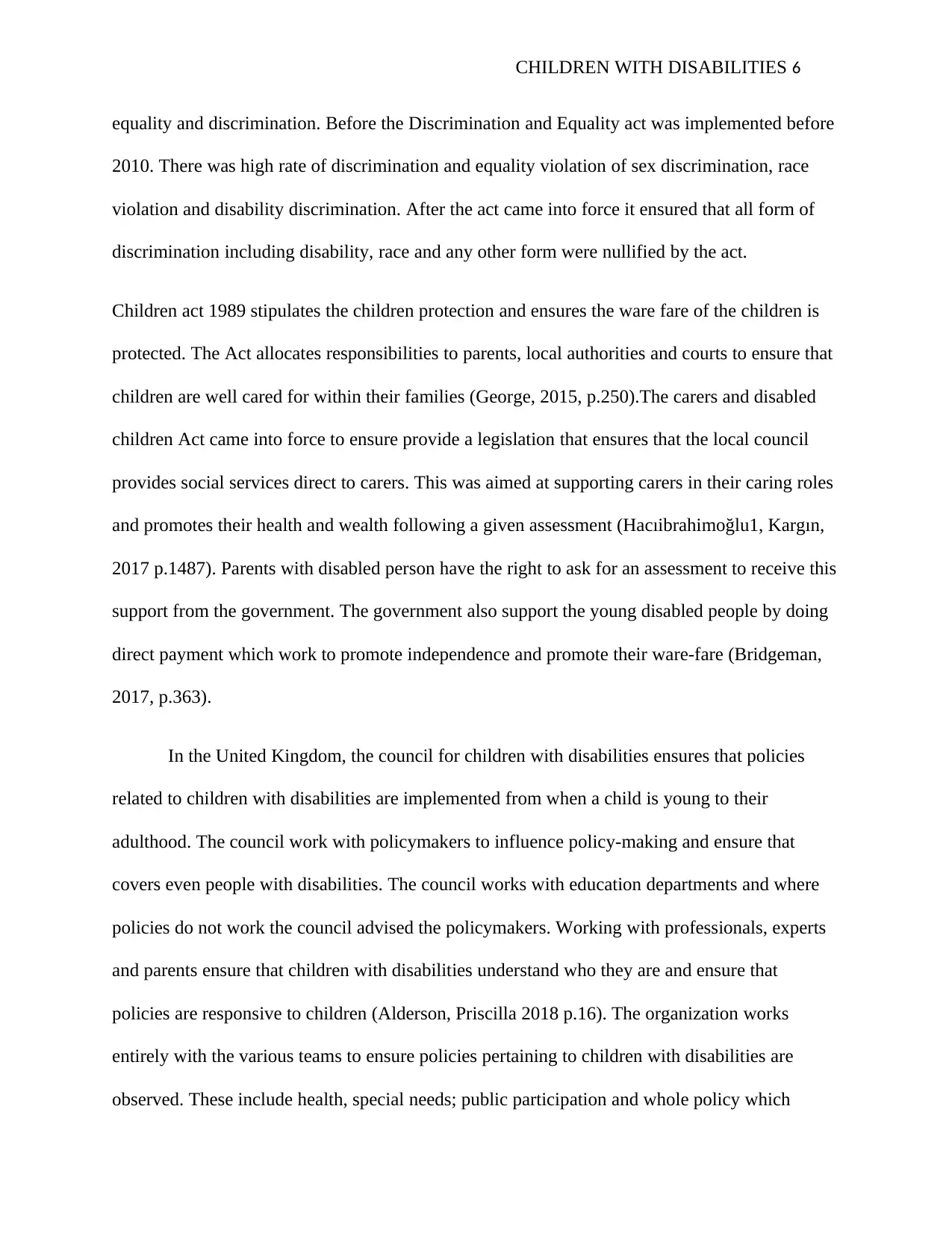
CHILDREN WITH DISABILITIES 6
equality and discrimination. Before the Discrimination and Equality act was implemented before
2010. There was high rate of discrimination and equality violation of sex discrimination, race
violation and disability discrimination. After the act came into force it ensured that all form of
discrimination including disability, race and any other form were nullified by the act.
Children act 1989 stipulates the children protection and ensures the ware fare of the children is
protected. The Act allocates responsibilities to parents, local authorities and courts to ensure that
children are well cared for within their families (George, 2015, p.250).The carers and disabled
children Act came into force to ensure provide a legislation that ensures that the local council
provides social services direct to carers. This was aimed at supporting carers in their caring roles
and promotes their health and wealth following a given assessment (Hacıibrahimoğlu1, Kargın,
2017 p.1487). Parents with disabled person have the right to ask for an assessment to receive this
support from the government. The government also support the young disabled people by doing
direct payment which work to promote independence and promote their ware-fare (Bridgeman,
2017, p.363).
In the United Kingdom, the council for children with disabilities ensures that policies
related to children with disabilities are implemented from when a child is young to their
adulthood. The council work with policymakers to influence policy-making and ensure that
covers even people with disabilities. The council works with education departments and where
policies do not work the council advised the policymakers. Working with professionals, experts
and parents ensure that children with disabilities understand who they are and ensure that
policies are responsive to children (Alderson, Priscilla 2018 p.16). The organization works
entirely with the various teams to ensure policies pertaining to children with disabilities are
observed. These include health, special needs; public participation and whole policy which
equality and discrimination. Before the Discrimination and Equality act was implemented before
2010. There was high rate of discrimination and equality violation of sex discrimination, race
violation and disability discrimination. After the act came into force it ensured that all form of
discrimination including disability, race and any other form were nullified by the act.
Children act 1989 stipulates the children protection and ensures the ware fare of the children is
protected. The Act allocates responsibilities to parents, local authorities and courts to ensure that
children are well cared for within their families (George, 2015, p.250).The carers and disabled
children Act came into force to ensure provide a legislation that ensures that the local council
provides social services direct to carers. This was aimed at supporting carers in their caring roles
and promotes their health and wealth following a given assessment (Hacıibrahimoğlu1, Kargın,
2017 p.1487). Parents with disabled person have the right to ask for an assessment to receive this
support from the government. The government also support the young disabled people by doing
direct payment which work to promote independence and promote their ware-fare (Bridgeman,
2017, p.363).
In the United Kingdom, the council for children with disabilities ensures that policies
related to children with disabilities are implemented from when a child is young to their
adulthood. The council work with policymakers to influence policy-making and ensure that
covers even people with disabilities. The council works with education departments and where
policies do not work the council advised the policymakers. Working with professionals, experts
and parents ensure that children with disabilities understand who they are and ensure that
policies are responsive to children (Alderson, Priscilla 2018 p.16). The organization works
entirely with the various teams to ensure policies pertaining to children with disabilities are
observed. These include health, special needs; public participation and whole policy which
⊘ This is a preview!⊘
Do you want full access?
Subscribe today to unlock all pages.

Trusted by 1+ million students worldwide
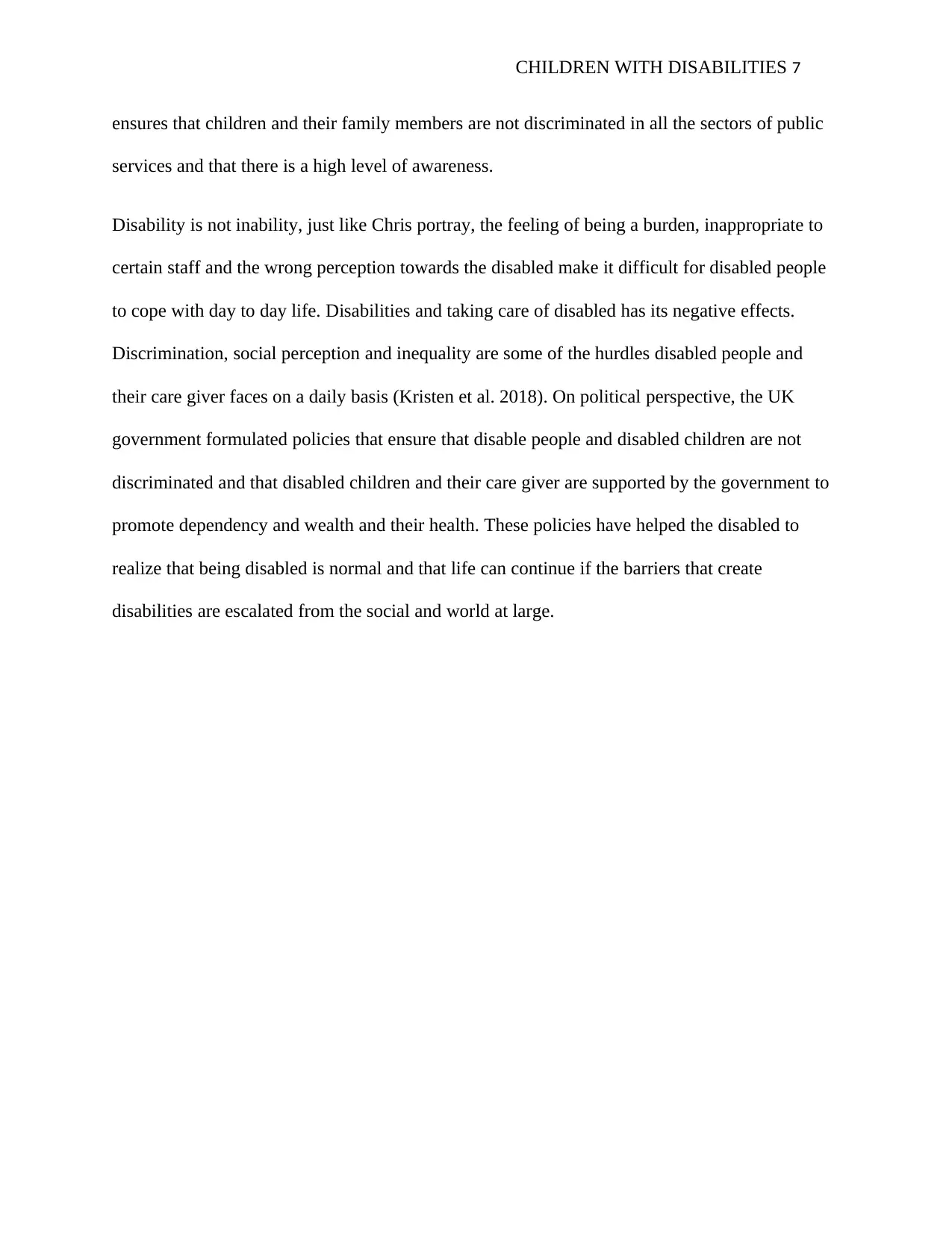
CHILDREN WITH DISABILITIES 7
ensures that children and their family members are not discriminated in all the sectors of public
services and that there is a high level of awareness.
Disability is not inability, just like Chris portray, the feeling of being a burden, inappropriate to
certain staff and the wrong perception towards the disabled make it difficult for disabled people
to cope with day to day life. Disabilities and taking care of disabled has its negative effects.
Discrimination, social perception and inequality are some of the hurdles disabled people and
their care giver faces on a daily basis (Kristen et al. 2018). On political perspective, the UK
government formulated policies that ensure that disable people and disabled children are not
discriminated and that disabled children and their care giver are supported by the government to
promote dependency and wealth and their health. These policies have helped the disabled to
realize that being disabled is normal and that life can continue if the barriers that create
disabilities are escalated from the social and world at large.
ensures that children and their family members are not discriminated in all the sectors of public
services and that there is a high level of awareness.
Disability is not inability, just like Chris portray, the feeling of being a burden, inappropriate to
certain staff and the wrong perception towards the disabled make it difficult for disabled people
to cope with day to day life. Disabilities and taking care of disabled has its negative effects.
Discrimination, social perception and inequality are some of the hurdles disabled people and
their care giver faces on a daily basis (Kristen et al. 2018). On political perspective, the UK
government formulated policies that ensure that disable people and disabled children are not
discriminated and that disabled children and their care giver are supported by the government to
promote dependency and wealth and their health. These policies have helped the disabled to
realize that being disabled is normal and that life can continue if the barriers that create
disabilities are escalated from the social and world at large.
Paraphrase This Document
Need a fresh take? Get an instant paraphrase of this document with our AI Paraphraser
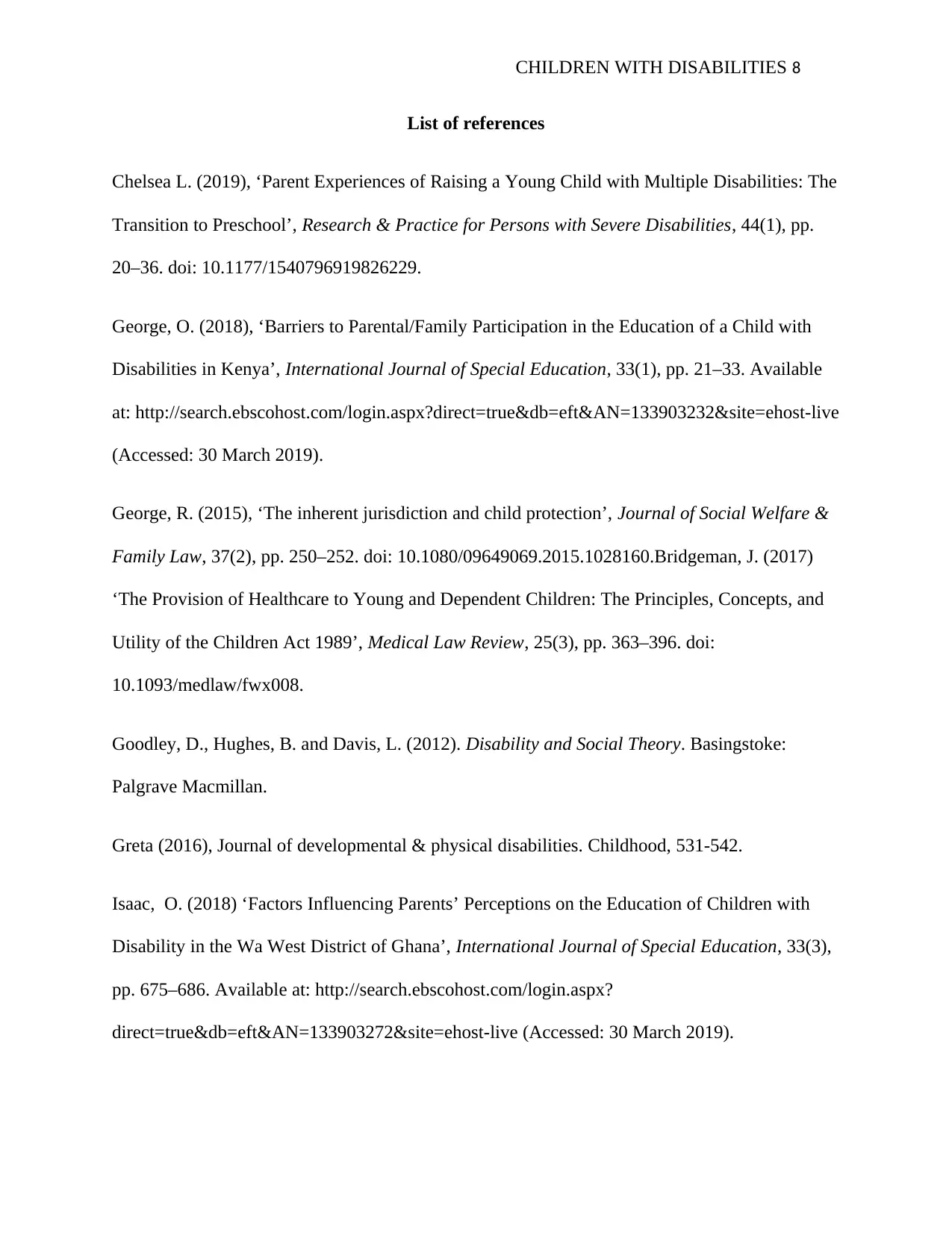
CHILDREN WITH DISABILITIES 8
List of references
Chelsea L. (2019), ‘Parent Experiences of Raising a Young Child with Multiple Disabilities: The
Transition to Preschool’, Research & Practice for Persons with Severe Disabilities, 44(1), pp.
20–36. doi: 10.1177/1540796919826229.
George, O. (2018), ‘Barriers to Parental/Family Participation in the Education of a Child with
Disabilities in Kenya’, International Journal of Special Education, 33(1), pp. 21–33. Available
at: http://search.ebscohost.com/login.aspx?direct=true&db=eft&AN=133903232&site=ehost-live
(Accessed: 30 March 2019).
George, R. (2015), ‘The inherent jurisdiction and child protection’, Journal of Social Welfare &
Family Law, 37(2), pp. 250–252. doi: 10.1080/09649069.2015.1028160.Bridgeman, J. (2017)
‘The Provision of Healthcare to Young and Dependent Children: The Principles, Concepts, and
Utility of the Children Act 1989’, Medical Law Review, 25(3), pp. 363–396. doi:
10.1093/medlaw/fwx008.
Goodley, D., Hughes, B. and Davis, L. (2012). Disability and Social Theory. Basingstoke:
Palgrave Macmillan.
Greta (2016), Journal of developmental & physical disabilities. Childhood, 531-542.
Isaac, O. (2018) ‘Factors Influencing Parents’ Perceptions on the Education of Children with
Disability in the Wa West District of Ghana’, International Journal of Special Education, 33(3),
pp. 675–686. Available at: http://search.ebscohost.com/login.aspx?
direct=true&db=eft&AN=133903272&site=ehost-live (Accessed: 30 March 2019).
List of references
Chelsea L. (2019), ‘Parent Experiences of Raising a Young Child with Multiple Disabilities: The
Transition to Preschool’, Research & Practice for Persons with Severe Disabilities, 44(1), pp.
20–36. doi: 10.1177/1540796919826229.
George, O. (2018), ‘Barriers to Parental/Family Participation in the Education of a Child with
Disabilities in Kenya’, International Journal of Special Education, 33(1), pp. 21–33. Available
at: http://search.ebscohost.com/login.aspx?direct=true&db=eft&AN=133903232&site=ehost-live
(Accessed: 30 March 2019).
George, R. (2015), ‘The inherent jurisdiction and child protection’, Journal of Social Welfare &
Family Law, 37(2), pp. 250–252. doi: 10.1080/09649069.2015.1028160.Bridgeman, J. (2017)
‘The Provision of Healthcare to Young and Dependent Children: The Principles, Concepts, and
Utility of the Children Act 1989’, Medical Law Review, 25(3), pp. 363–396. doi:
10.1093/medlaw/fwx008.
Goodley, D., Hughes, B. and Davis, L. (2012). Disability and Social Theory. Basingstoke:
Palgrave Macmillan.
Greta (2016), Journal of developmental & physical disabilities. Childhood, 531-542.
Isaac, O. (2018) ‘Factors Influencing Parents’ Perceptions on the Education of Children with
Disability in the Wa West District of Ghana’, International Journal of Special Education, 33(3),
pp. 675–686. Available at: http://search.ebscohost.com/login.aspx?
direct=true&db=eft&AN=133903272&site=ehost-live (Accessed: 30 March 2019).

CHILDREN WITH DISABILITIES 9
Kargın, T. (2017) ‘Determining the Difficulties Children with Special Needs Experience during
the Transition to Primary School’, Educational Sciences: Theory & Practice, 17(5), pp. 1487–
1524. doi: 10.12738/estp.2017.5.0135.
Kristen, F. (2018) ‘Grand Challenges in School Social Work: Collaboration and Constraint in
School Social Workers’ Sexuality Support for Children with Disabilities’, Children & Schools,
40(1), pp. 25–34. doi: 10.1093/cs/cdx027.
Masulani, C. (2019), ‘Development of a psycho-social intervention for reducing psychological
distress among parents of children with intellectual disabilities in Malawi’, PLoS ONE, 14(2),
pp. 1–13. doi: 10.1371/journal.pone.0210855.
Mawene (2018), ‘Factors Influencing Parents’ Selection of Schools for Children with
Disabilities: A Systematic Review of the Literature’, International Journal of Special Education,
33(2), pp. 313–329. Available at: http://search.ebscohost.com/login.aspx?
direct=true&db=eft&AN=133903251&site=ehost-live (Accessed: 30 March 2019).
Park(2018), ‘A Phenomenological Study of Parenting Stress Among Korean Mothers of Deaf
Children’, American Annals of the Deaf, vol. 163, no. 4, pp. 440–462, viewed 30 March 2019,
<http://search.ebscohost.com/login.aspx?direct=true&db=eft&AN=132535149&site=ehost-
live>.
Priscilla (2018), “How the Rights of All School Students and Teachers Are Affected by Special
Educational Needs or Disability (SEND) Services: Teaching, Psychology, Policy.” London
Review of Education 16, no. 2 (July 2018): 175–90. doi:10.18546/LRE.16.2.01.
Kargın, T. (2017) ‘Determining the Difficulties Children with Special Needs Experience during
the Transition to Primary School’, Educational Sciences: Theory & Practice, 17(5), pp. 1487–
1524. doi: 10.12738/estp.2017.5.0135.
Kristen, F. (2018) ‘Grand Challenges in School Social Work: Collaboration and Constraint in
School Social Workers’ Sexuality Support for Children with Disabilities’, Children & Schools,
40(1), pp. 25–34. doi: 10.1093/cs/cdx027.
Masulani, C. (2019), ‘Development of a psycho-social intervention for reducing psychological
distress among parents of children with intellectual disabilities in Malawi’, PLoS ONE, 14(2),
pp. 1–13. doi: 10.1371/journal.pone.0210855.
Mawene (2018), ‘Factors Influencing Parents’ Selection of Schools for Children with
Disabilities: A Systematic Review of the Literature’, International Journal of Special Education,
33(2), pp. 313–329. Available at: http://search.ebscohost.com/login.aspx?
direct=true&db=eft&AN=133903251&site=ehost-live (Accessed: 30 March 2019).
Park(2018), ‘A Phenomenological Study of Parenting Stress Among Korean Mothers of Deaf
Children’, American Annals of the Deaf, vol. 163, no. 4, pp. 440–462, viewed 30 March 2019,
<http://search.ebscohost.com/login.aspx?direct=true&db=eft&AN=132535149&site=ehost-
live>.
Priscilla (2018), “How the Rights of All School Students and Teachers Are Affected by Special
Educational Needs or Disability (SEND) Services: Teaching, Psychology, Policy.” London
Review of Education 16, no. 2 (July 2018): 175–90. doi:10.18546/LRE.16.2.01.
⊘ This is a preview!⊘
Do you want full access?
Subscribe today to unlock all pages.

Trusted by 1+ million students worldwide

CHILDREN WITH DISABILITIES 10
Sara M .(2018) ‘Teaching Play Skills to Children with Disabilities: Research-Based
Interventions and Practices’, Early Childhood Education Journal, 46(6), pp. 587–599. doi:
10.1007/s10643-018-0917-7.
Theresa J. (2017), ‘Employed Parents of Children with Disabilities and Work Family Life
Balance: A Literature Review’, Child & Youth Care Forum, 46(6), pp. 857–876. doi:
10.1007/s10566-017-9407-0.
Sara M .(2018) ‘Teaching Play Skills to Children with Disabilities: Research-Based
Interventions and Practices’, Early Childhood Education Journal, 46(6), pp. 587–599. doi:
10.1007/s10643-018-0917-7.
Theresa J. (2017), ‘Employed Parents of Children with Disabilities and Work Family Life
Balance: A Literature Review’, Child & Youth Care Forum, 46(6), pp. 857–876. doi:
10.1007/s10566-017-9407-0.
1 out of 10
Related Documents
Your All-in-One AI-Powered Toolkit for Academic Success.
+13062052269
info@desklib.com
Available 24*7 on WhatsApp / Email
![[object Object]](/_next/static/media/star-bottom.7253800d.svg)
Unlock your academic potential
Copyright © 2020–2025 A2Z Services. All Rights Reserved. Developed and managed by ZUCOL.




